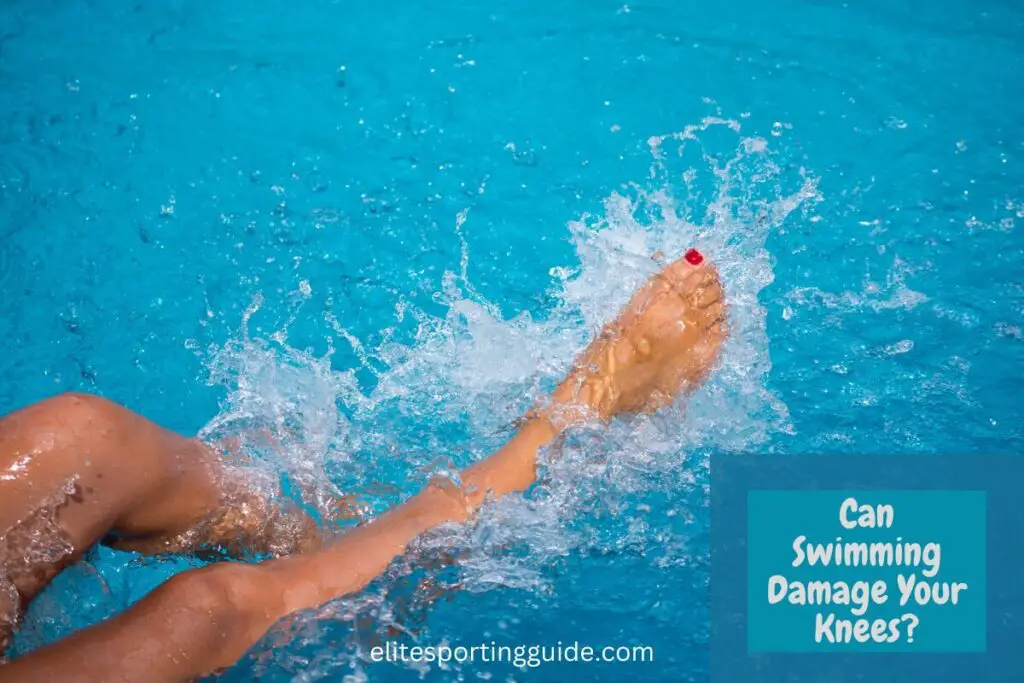In the world of fitness and sports, swimming is often celebrated as a joint-friendly exercise, praised for its low-impact nature and ability to provide a full-body workout.
However, there’s a lingering question that has crossed the minds of many: Can swimming, this seemingly gentle activity, actually have adverse effects on your knees?
In this article, we delve into the relationship between swimming and knee health.
We’ll explore the benefits of swimming for joint health, as well as potential pitfalls and factors that could lead to knee discomfort or injury while swimming.
Understanding these nuances will help you make informed decisions about incorporating swimming into your fitness routine while safeguarding your knee health.
Can Swimming Damage Your Knees?
Swimming is considered ‘easy on the knees’ as it is a low-impact exercise. The buoyancy of water reduces the stress on your joints, making it a suitable activity for individuals with knee issues. However, improper swimming techniques or overuse can potentially lead to knee problems, so it’s important to maintain good form and listen to your body to prevent any potential damage.
The Low-Impact Reputation of Swimming
The low-impact reputation of swimming refers to the widely held belief that swimming is a form of exercise that places minimal stress and strain on the body’s joints, particularly the knees.
This reputation is based on the biomechanics of swimming in water, where the buoyancy of the water reduces the impact of gravity on the body, making individuals feel lighter and decreasing the forces acting on their joints.
Swimming is often praised for its low-impact nature because the water’s buoyancy helps support the body’s weight, thereby reducing the risk of joint-related injuries and discomfort.
This makes swimming an attractive option for people with conditions such as arthritis, joint pain, or previous injuries, as well as those looking for a full-body workout without the high impact that can be associated with activities like running or weightlifting.
However, it’s important to note that while swimming is generally considered low-impact, the extent of its impact can vary depending on factors like swimming technique, intensity, and duration.
Incorrect swimming form or overexertion can still potentially lead to strain or injuries, underscoring the importance of maintaining proper technique and pacing during aquatic exercise.
The Science of Buoyancy and Knee Health
The science of buoyancy and knee health relates to the physics of how water’s buoyant force affects the stress and strain on the knee joints during activities like swimming.
Understanding this science is crucial in assessing the impact of water-based exercises on knee health.
Buoyancy is a fundamental principle in fluid dynamics that explains why objects submerged in water appear to weigh less than they do in air.
When a person is in the water, the buoyant force exerted by the water opposes the force of gravity.
This buoyant force essentially counteracts the gravitational pull on the body, making individuals feel lighter in water.
As a result, the stress and impact on the joints, including the knees, are significantly reduced compared to activities on dry land.
The key takeaway is that the buoyancy of water cushions the body, reducing the compressive forces on the knees that are commonly associated with high-impact exercises like running or jumping.
This property of water is one of the reasons why swimming is often considered a low-impact exercise and is generally gentle on the joints, making it a suitable choice for individuals with knee issues or those looking to protect their knee health.
Benefits of Swimming for Knee Health
Swimming offers several benefits for knee health, making it an appealing exercise option for individuals with knee issues or those looking to prevent them:
1. Low-Impact Exercise: Swimming is a low-impact activity that reduces the stress on knee joints compared to high-impact sports like running.
The buoyancy of water provides a cushioning effect, lessening the impact on the knees.
2. Improved Range of Motion: Swimming involves a wide range of motion in the legs, which can help improve joint flexibility.
This can be particularly beneficial for individuals with knee stiffness or reduced mobility.
3. Muscle Strengthening: Swimming engages various muscle groups, including those around the knees.
Regular swimming can help strengthen the muscles that support the knee joint, providing added stability and reducing the risk of injury.
4. Cardiovascular Fitness: Swimming is an excellent cardiovascular workout that enhances overall fitness without putting excessive strain on the knees.
Maintaining a healthy weight through swimming can also relieve pressure on knee joints.
5. Pain Management: For individuals with certain knee conditions, like osteoarthritis, swimming can provide pain relief.
The buoyancy of water can alleviate discomfort during exercise.
6. Rehabilitation: Swimming is often recommended by healthcare professionals as part of rehabilitation programs for knee injuries.
It allows patients to regain strength and mobility while minimizing impact.
7. Weight Management: Maintaining a healthy weight is crucial for knee health.
Swimming can aid in weight management, reducing the load on the knees and helping prevent or alleviate knee problems.
8. Low Risk of Overuse Injuries: Swimming typically carries a lower risk of overuse injuries commonly associated with repetitive motions in high-impact activities.
9. Stress Reduction: Engaging in water-based exercise can have a relaxing effect, potentially reducing stress and tension, which can indirectly benefit overall joint health.
It’s important to note that while swimming offers numerous advantages for knee health, individuals should still maintain proper swimming techniques and be cautious not to overexert themselves, as improper form or excessive strain can lead to knee issues.
Potential Knee Issues in Swimming
While swimming is generally considered a low-impact exercise that is kind to the knees, there are still potential knee issues that individuals should be aware of:
1. Swimmer’s Knee (Patellofemoral Pain Syndrome): This condition can occur when the patella (kneecap) rubs against the femur (thigh bone) during swimming, leading to pain and discomfort.
It may be exacerbated by improper kicking techniques or poor body positioning in the water.
2. Rotator Cuff Injuries: Although primarily a shoulder issue, rotator cuff injuries can indirectly affect knee health if they lead to changes in swimming form.
Altered stroke mechanics may put additional stress on the knees.
3. Overuse Injuries: Swimming long distances without proper rest and recovery can lead to overuse injuries, including tendonitis or stress fractures.
These injuries may not affect the knees directly but can alter swimming techniques, indirectly impacting knee health.
4. Knee Tendinitis: Repetitive kicking in certain swimming styles, such as the flutter kick in freestyle and backstroke, can lead to knee tendinitis, causing pain and inflammation in the knee tendons.
5. Improper Turns and Push-offs: Incorrect execution of turns and push-offs from the pool wall can strain the knees, potentially leading to injury over time.
6. Pre-Existing Knee Conditions: Individuals with pre-existing knee conditions, such as arthritis or ligament injuries, should be cautious while swimming.
While swimming is generally joint-friendly, it’s essential to adapt strokes and techniques to avoid exacerbating these conditions.
7. Muscle Imbalances: Poor muscle balance or weakness in the leg muscles can affect knee stability during swimming.
Strengthening exercises and proper swim training can help address this issue.
10. Hypermobility: Some individuals naturally have hypermobile joints, including the knees.
While swimming can be beneficial, it’s essential for those with hypermobility to maintain good form to prevent joint strain.
Improper Techniques and Knee Strain
Improper swimming techniques can contribute to knee strain, which is an important consideration when evaluating the impact of swimming on knee health.
Here are some ways in which improper techniques can lead to knee strain in swimming:
1. Kicking Techniques: Inefficient kicking techniques, such as excessive knee bending during the flutter kick, can put undue stress on the knee joints.
Kicking from the hips with a slight knee bend is the correct technique to avoid straining the knees.
2. Breaststroke Technique: The breaststroke, while a graceful and effective stroke, can potentially strain the knees if executed improperly.
Swimmers who bring their heels too close to their buttocks during the whip kick may experience knee discomfort.
Proper timing and form are crucial to minimize knee strain.
3. Body Positioning: Maintaining proper body positioning in the water is essential to prevent knee strain.
If a swimmer’s body is not aligned correctly, it can create drag and force the knees into unnatural angles, leading to strain.
4. Excessive Force: Overexerting or using excessive force during swimming strokes can also stress the knees.
This often happens when swimmers try to push too hard with their kicks or pull too forcefully with their arms, leading to improper body mechanics and potential knee strain.
5. Flip Turns: Incorrect execution of flip turns can place stress on the knees.
Swimmers who twist their bodies too abruptly or push off the wall forcefully with a locked knee can experience knee discomfort.
6. Inadequate Warm-Up: Skipping a proper warm-up before swimming can lead to cold and stiff muscles, making them more prone to injury, including knee strain.
7. Neglecting Flexibility: A lack of flexibility in the ankles and hip flexors can contribute to improper swimming techniques that strain the knees. Stretching and mobility exercises can help mitigate this risk.
To reduce the potential for knee strain in swimming, it’s essential to prioritize proper form and technique.
Post you may be interested in: Can Swimming Damage Your Skin?
Overuse and Knee Overload
Overuse and knee overload are potential issues that can arise in swimming, especially if individuals engage in excessive training without adequate rest and recovery.
Here’s how overuse and knee overload can affect knee health in swimming:
1. Repetitive Movements: Swimming involves repetitive leg movements, particularly kicking, which can strain the knee joints over time.
Swimmers who log long hours in the pool without proper rest may experience overuse injuries, including knee discomfort.
2. Increased Training Intensity: Intensifying training too quickly or pushing the body beyond its limits can lead to knee overload.
This often happens when swimmers increase their distance or training volume without allowing their knees to adapt to the higher demands.
3. Inadequate Recovery: Proper recovery is essential to prevent overuse injuries.
Failing to rest and recover between swim sessions can lead to cumulative stress on the knees and other joints, potentially resulting in knee problems.
4. Technique Deterioration: Fatigue from overtraining can cause swimmers to compromise their technique, leading to inefficient movements and increased strain on the knees.
5. Nutrition and Hydration: Inadequate nutrition and hydration can contribute to overuse injuries by reducing the body’s ability to repair and recover from the stress of swimming.
6. Preventing Knee Overload: To prevent overuse and knee overload in swimming, it’s essential to incorporate rest days into the training schedule, gradually increase training intensity and volume, and pay attention to proper nutrition and hydration.
Additionally, swimmers should be mindful of their technique and body mechanics even when fatigued to avoid putting excessive strain on the knees.
7. Listen to the Body: Paying attention to the body’s signals is crucial. If a swimmer experiences persistent knee discomfort or pain, it’s important to rest and seek medical advice to prevent worsening the condition.
Balancing training intensity with adequate recovery, monitoring technique, and maintaining overall health and fitness can help mitigate the risk of overuse and knee overload in swimming.
Preventing Knee Problems in Swimming

1. Proper Technique: Ensure you are using correct swimming techniques, especially for kicking and turns.
Work with a coach or instructor to refine your form and reduce the risk of strain on the knees.
2. Gradual Progression: Avoid sudden increases in training intensity or distance.
Gradually build up your swimming workouts to allow your knees to adapt to the demands of the activity.
3. Stretching and Mobility: Incorporate regular stretching and mobility exercises into your routine to maintain flexibility in the knees and surrounding muscles.
Focus on stretches that target the quadriceps, hamstrings, and hip flexors.
4. Strength Training: Include strength training exercises for the legs, such as squats and lunges, to build muscle around the knee joint.
Strong leg muscles provide added stability and support for the knees.
5. Rest and Recovery: Prioritize rest days and recovery between swim sessions to allow your body, including your knees, to heal and adapt. Overtraining can lead to overuse injuries.
6. Nutrition and Hydration: Maintain a balanced diet and stay properly hydrated to support muscle recovery and overall joint health.
7. Warm-Up and Cool Down: Always start your swim with a thorough warm-up to prepare your muscles and joints.
After your swim, engage in a cool-down routine to help reduce muscle stiffness and promote recovery.
8. Listen to Your Body: Pay attention to any signs of discomfort or pain in your knees. If you experience persistent knee issues, consult a healthcare professional for evaluation and guidance.
9. Equipment Check: Ensure your swimming gear, such as fins or kickboards, is in good condition and appropriate for your skill level and training goals.
Ill-fitting or worn-out equipment can contribute to knee strain.
10. Avoid Overuse: Be mindful of the volume and frequency of your training. Avoid excessive kicking or strenuous workouts that may put unnecessary strain on your knees.
When to Seek Medical Advice
Seeking medical advice is crucial when you experience any persistent or severe knee problems during or after swimming. Here are some specific situations when it’s essential to consult a healthcare professional:
1. Persistent Pain: If you consistently experience knee pain, discomfort, or swelling during or after swimming, even if it’s mild, it’s important to seek medical advice.
Ignoring persistent pain can lead to more serious issues.
2. Limited Range of Motion: If you notice a decreased range of motion in your knee joint or have difficulty fully extending or bending your knee, it’s a sign that something may be wrong, and a medical evaluation is warranted.
3. Swelling and Inflammation: Significant swelling and inflammation in the knee joint should not be ignored. It could indicate an injury or underlying condition that requires attention.
4. Locking or Instability: If your knee locks or feels unstable during swimming or other activities, this may be a sign of a structural problem with the knee, such as a meniscus tear or ligament injury.
5. Audible Popping or Clicking: If you hear popping or clicking sounds coming from your knee joint while swimming, it could indicate an issue with the joint or surrounding structures.
6. Previous Knee Injuries: If you have a history of knee injuries or surgeries, it’s wise to consult a healthcare professional if you experience any new or worsening symptoms while swimming.
7. Persistent Discomfort After Rest: If knee discomfort persists even after adequate rest and recovery, it’s a clear signal that you should seek medical advice to identify the root cause.
8. Changes in Gait: If you notice changes in your walking or running gait due to knee pain or instability acquired during swimming, it’s important to have it evaluated to prevent further complications.
9. Loss of Strength: If you experience a noticeable decrease in the strength of your knee or leg muscles, it could indicate an underlying issue that requires assessment.
10. Medical History: If you have a family history of knee problems or conditions such as osteoarthritis, it’s advisable to consult a healthcare professional for preventive guidance and early detection.
Remember that maintaining proper knee health in swimming is not just about preventing injuries but also about enjoying the many benefits of this low-impact exercise.
By taking a proactive approach to knee care and incorporating these preventive measures into your routine, you can swim comfortably and confidently for years to come.
Post you may like: Can Swimming Damage Your Eyes?
Swimming’s Impact on Knee Health
In conclusion, swimming’s impact on knee health is a complex interplay of benefits and potential risks.
It is widely recognized as a low-impact exercise that offers numerous advantages for joint health.
The buoyancy of water reduces the strain on the knees, making it an excellent choice for individuals with knee issues or those looking to maintain overall joint fitness.
Swimming can improve range of motion, strengthen supporting muscles, and provide cardiovascular benefits while minimizing the risk of high-impact injuries.
However, it’s essential to approach swimming with awareness and diligence.
Improper techniques, overuse, and failure to listen to the body can lead to knee problems in swimmers.
While the overall risk is relatively low compared to many other sports and activities, it is crucial to prioritize proper form, gradual progression, and rest and recovery.
Ultimately, swimming can be a valuable component of a healthy lifestyle, promoting knee health when practiced mindfully.
By combining the benefits of swimming with a commitment to good technique, fitness, and preventive measures, individuals can enjoy the water while safeguarding their knee health for years to come.
Regular consultation with healthcare professionals and seeking prompt medical advice when needed are essential for maintaining knee health while swimming.



